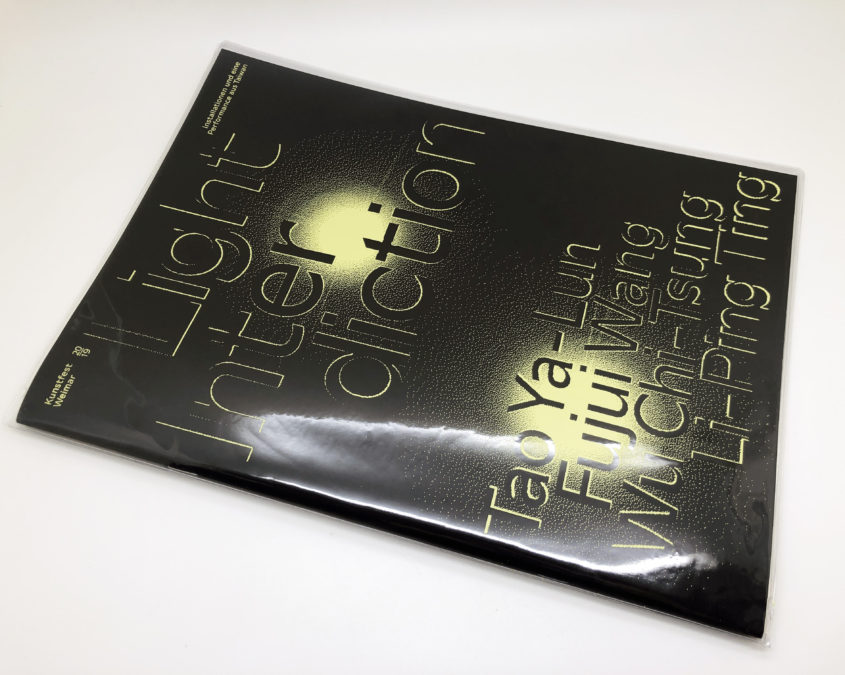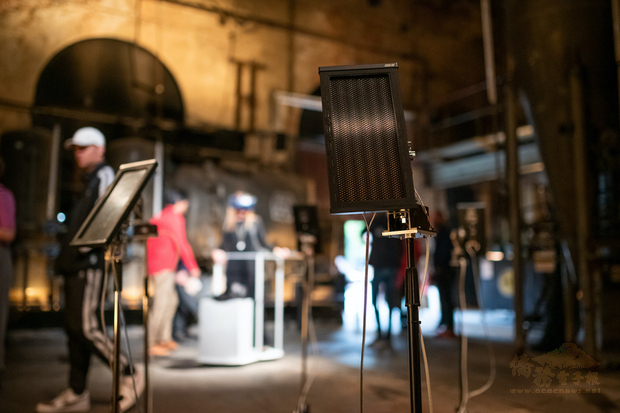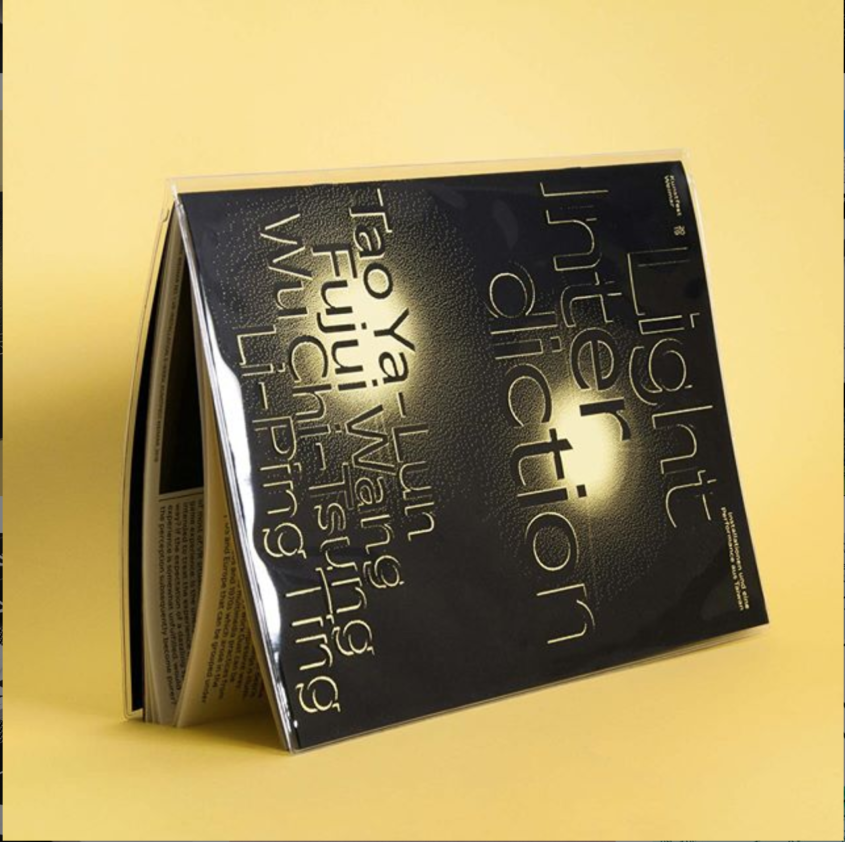此文章於KUNSTFEST WEIMAR 2019 威瑪藝術節,E-WERK WEIMAR,Light Interdiction 專刊
English Text 英文撰文:Gabriele de Seta
English Translator 英文翻譯:Sylvie Lin
Chinese Translator 中文翻譯:Lu Yi
Graphic Design 設計:Lukas Kung (Burow, berlin)
Publication Realized 出版:Idolonstudio
Publication Editor:Chun-chi Wang
Year 年份:2019
Through the air, into the ear: Fujui Wang’s Hollow Noise
經由空氣至耳朵:王福瑞的雜音空態
儘管我聽到風荒涼的嘯聲並感覺到窣冷,但我看不見它扭曲的扭動,它用它無形的存在包圍著我。不論我努力地極目而視,看不見的就是視線。
—哲學家唐·伊德,聆聽與聲音: 聲音的現象學 (1976, p. 51)
聽覺經驗來自對立和例外的想像:音符之間散佈著停頓、聲音中點綴著沉默、音樂因噪音而升起、人聲超越四周雜音、和聲因不和諧而失調、聽覺從聆聽上變得完美……等。方向性的、目的論的與焦點的隱喻帶領了聽覺感知的想像力:豎立一隻耳朵,豎起耳朵,保持耳朵張開。人類作為以耳朵立足的生物,想像自己遍歷這個刺激的世界,並用熟練的感官或技術設備將其拾起。耳朵收集並轉述發現的聲音、遙遠的信號、令人愉悅的氛圍、精選的播放清單、悲傷的喧嘩。媒體通常置於聲音感知的前端和中心 – 耳機、麥克風、喇叭單體、錄音機、黑膠唱片、卡帶、CD、MP3 – 但是聲音的第一媒介本身卻經常被遺忘:空氣。哲學家唐·伊德(Don Ihde)從他的現象學查訪中明確地獲得此聽覺體驗。「我們知道,我們沉浸生活在一個巨大卻無形的空氣海洋,那包圍並滲透著我們,沒有它,我們的生命必定會脫離我們。」(Ihde, 1976, p. 3) 我們本能地知道我們需要呼吸空氣,但是我們常常忘記了空氣是如何介導所有聲音的,以至於大多數人類的聲景都可以歸因為空氣分子的振動。正如人類學家蒂姆·英戈爾德(Tim Ingold)的挑釁性所暗示的那樣,如果聲音比景觀更類似於天氣(Ingold, 2007),則將我們的聲音周圍環境視為由流動和湍流交錯的感知空間,似乎比將它們描述為扁平化的表示更精確於他們的視覺對應。
正如伊德所提:「“[i]t is to the invisible that listening may attend” (1976, p. 14),但是變得逐漸更重要的是觀察這個無形振動世界的譬喻。聆聽將注意力轉移到聽眾周圍的領域,而這又可以成為關注的焦點:聆聽“場域為場域”展現其邊界時,聲學的視野總是在其他感官的界限附近波動著,從不與任何感官完全重疊,但超出或不足於它們的掌握。轉向經驗的聽覺維度會引領至一種野外狀態,在這種狀態下,即使周圍環境平淡無聊,對普通聲音的熟悉發展成一種具有自身維度和方向性的現象學性的聆聽(1976, p. 40)。」伊德提到:「聲音是持續不斷地呈現的體驗(1976, p. 81)」,但是媒介的相對抵抗可以區分不同的類別,例如聲音和靜音,音樂和噪音,和諧與不和諧,如此才將它們視為相對的極端或專有本體論的類別。
王福瑞的《雜音空態》將這些概念集中在聲音的計量學與聽覺領域的現象學經驗上,顯著的極簡主義但很豐富之作。《雜音空態》作品使用八個HyperSound® HSS300指向性喇叭,美國公司Turtle Beach通過生產獨特的喇叭,能夠將狹窄的超聲波束投射到聚焦區域,完美體現標榜的HyperSound技術:通過2個超音波的調變產生可聽見的聲音,因此指向喇叭產生具定向性與具身歷其境的音頻體驗,似乎從空間中展現特定點的薄空氣。
王從2011年就一直進行這些喇叭實驗,推動喇叭的定向能力和頻率範圍 – 在這種情況下,他對它們編寫了程式,使其移動投射白噪音聲束相應地至展覽空間的空間配置。自動移動的多個喇叭重新配置改變了指向喇叭的原始目的(分散的公共廣播系統與不干擾的媒體消費),通過將超音波束散射到整個空間並通過折射展覽場地的建築特徵而產生偶然的干擾。王福瑞描述其結果視為一種空氣現象。指向性的聲音從四面八方而來,像風切般進入人們的耳朵,極窄般聲波的傳輸被折射似的般困在兩個鏡子之間,通過多個控制器的運動和多個牆壁的折射,喇叭在空間中產生類似雷射光的連續不斷繞射的聲音。
《雜音空態》的體驗跨越了聲音藝術的聆聽,與陷入一種幻覺陷阱之間的界限,當謎一般的黑色指向喇叭表面 – 以程式模式移動,但看起來很安靜 – 似乎與白噪音的陣風無關,卻突然穿透空氣進入耳朵。除了風之外,王還提到流體動力學,以解釋他的作品想要培養的聽覺體驗。如果聽眾閉上眼睛並感覺,他們會看到像海浪一樣的東西,簡單地由水組成,但層層不斷豐富變化。海浪的聲音不斷地相互撞擊,可能會帶領他們進入多個虛幻世界,或家鄉的記憶,因為他們深深地沉浸在一個空的[聆聽]狀態中。
王福瑞的空氣構成利用超音波折射和交織運動來應證伊德(Ihde)所謂的一個聆聽的「場域狀態」,在這種狀態下,觀眾自己的聆聽實踐有助於在裝置的聲音空間之外創造內部體驗空間。最後但同樣重要的是,白噪音是一個方程式(*註1)裡的重要組成部分:正如David Novak強調的那樣,實驗音樂家經常將白噪音作為聲源或美學參考,為「一個理想聲音的存在,包含所有可聽見的頻率同時以相等的音量播放」 (Novak, 2013, p. 124)。王以台灣噪音音樂的先驅者作為職業生涯,無疑在這一美學決定中扮演了一個角色,但從更概念層次上來說,他強調選擇白噪音是「不具任何意義」的「純音」,以及儘可能減低干擾場域的狀態(*註2)。
一個矛盾仍然存在:如果總是以聲音為媒介,那麼「圍繞著我們的巨大但看不見的空氣海洋」中就會產生連續的漲潮和騷亂(Ihde, 1976, p. 3)。‘hollow’在作品裡的意思是什麼?為了找出答案,回到現象學的聽覺轉向是很有用的。雜音空態的描述斷定噪音是聲音的最抽象形式,它的空態等同於聲音藝術不可言說的必然性。在王福瑞的聲音藝術的創作,與視覺藝術的創作模式相反,是基於聲音現象學感知的隨機直覺和直觀決定的範圍。但是除了間接地提及聽覺的奧秘之外,白噪音的空態還指出了聲音與感官的重要性之間的重要關聯。在描繪聲音場域與其聲學界限的獨特特徵之後,唐.伊德從形狀和表面轉移到音量:迴聲(echo)和混響(reverberation)為聆聽打開了空間,並使聽眾可以感知其物理延伸和材料成分中的不可見部分 – 「隨著內在的聆聽,聆聽的可能性才開啓所有視覺主義思維視野中的道路,因為隨著內在的聆聽,無形的聽覺能力開始顯著地脫穎而出。」(1976, p. 70)
《雜音空態》超音波束如變化般似的探針,在牆的表面和空間的建築特徵,隨機帶回經由折射和衍射、迴聲和混響後材質和紋理的細節。這看不見的指引是由純粹、大部分無意義訊號和特定角度與空間點切入鼓膜所組成,在頻率之間這些不可預測的干擾下,消失就像出現一樣快速,新的方向驚艷了聆聽者。
王以手術般精細結合了全頻譜噪音(full-spectrum noise)與超音波音頻再現,從而消除了習慣性使用特定地點的聲音來填充空間的問題,而是使用了幻覺來使耳朵充滿該空間自身空洞的聲音痕跡。這矛盾性或許沒有出現於作品名字的英文中,其英文‘hollow’翻譯成中文kongtai,意思是指空的狀態。體驗王福瑞的《雜音空態》,是一種在新聲場及其維度關係的聽覺現象學的鍛鍊; 正如法國哲學家南希提到,這種聆聽是:『所謂諦聽,即同處外與內,於空於內皆開之。故由此至彼,由此入彼。』(Nancy, 2007, p. 14)
補充:關於“the invisible is the horizon of sight” :作者描述了他站在一個小山頂上,俯瞰著山下暴風中的景色,他聽到並感受的風的存在,但卻無法用視覺去看見風,延伸出聽覺同時也是在探究不可見的事物,聆聽使不可見的事物變成存在。
*註1:方程式是指,整個雜音空態的作品組成視為一個方程式,為白噪音+指向喇叭+馬達,而白噪音為方程式其中的一個部分。
*註2:王認為,在聲音中放入具意義的文本(例如對話、語言),會讓聽者有意識去思考其意義,而偏離他原有的想法,這樣同時在空間中也多產生一種聆聽的干擾,所以使用純白噪音可以作為一個較低干擾空間的方式。
Through the air, into the ear: Fujui Wang’s Hollow Noise
I hear its howling and feel its chill but I cannot see its contorted writhing though it surrounds me with its invisible presence. No matter how hard I look, I cannot see the wind, the invisible is the horizon of sight.
—Don Ihde, Listening and Voice: Phenomenologies of Sound (1976, p. 51)
Auditory experiences are often imagined in terms of oppositions and exclusions: notes interspersed by pauses, silences punctuated by sounds, music elevated over noise, voice rising above cacophony, harmony faulted by dissonance, listening perfected from hearing, and so on. Directional, teleological and focal metaphors guide the imagination of aural perception: lending a ear, pricking ears up, keeping one’s ears open. As ear-studded beings, humans envision themselves traversing a world of given stimuli and picking them up with their skilled senses or technical apparatuses. Ears collect and report found sounds, distant signals, pleasing ambiences, curated playlists, distressing clamors. Media are often at the front and center of sonic perception – earphones, microphones, speaker cones, recorders, vinyl records, cassettes, CDs, MP3s – but the first medium of sound itself is as often forgotten: air. Don Ihde begins his phenomenological investigation of auditory experience from precisely this realization: “We know that we live immersed in a vast but invisible ocean of air that surrounds us and permeates us and without which our life must necessarily escape us” (Ihde, 1976, p. 3). We instinctively know that we need air to breathe, but we often forget how air mediates all sound – to the point that most human soundscapes can be reduced to the vibration of air molecules. If, as anthropologist Tim Ingold has provocatively suggested, sound resembles more weather than landscape (Ingold, 2007), then attending to our sonic surroundings as perceptual spaces crisscrossed by flows and turbulences seems more accurate than depicting them as flattened representations modeled on their visual counterpart.
Surely, as Ihde suggests, “[i]t is to the invisible that listening may attend” (1976, p. 14), but what becomes increasingly important are the metaphors with which to attend to this invisible vibratory world. Listening turns attention towards a field surrounding the listener, which can in turn be made the focus of attention: listening to “the field as field” foregrounds its boundary, the acoustic horizon, which always fluctuates around the limits of one’s other senses, never overlapping with any of them entirely but exceeding or falling short of their grasp. This turn to the auditory dimension of experience leads to a field state where even the boredom of uneventful surroundings and the familiarity with ordinary sounds blossom into a kind of phenomenological listening with its own dimensionality and directionality (1976, p. 40). “Sound is continuously present to experience,” Ihde notes (1976, p. 81), but the medium’s relative resistance allows for the differentiation of shifting categories such as sound and silence, music and noise, harmony and dissonance,
Fujui Wang’s Hollow Noise condenses these thoughts on the metereology of sound and the phenomenological experience of auditory fields in a strikingly minimalist but generous work. As a sound installation, Hollow Noise relies on eight HyperSound® HSS300 directional speakers. The American company Turtle Beach has been perfecting their trademark HyperSound technology by producing unique speakers capable of projecting narrow beams of ultrasound towards focused areas: creating audible sound out of the interference pattern of two ultrasonic beams intersecting, hypersonic speakers offer an extremely directional and immersive experience of audio that seems to emerge out of thin air in specific points in space.
Wang has been experimenting with these speakers since 2011 – pushing their directional capabilities and frequency range – and has in this occasion programmed them to move accordingly to the spatial configuration of the exhibition space while they project beams of white noise. The speakers’ automated movements reconfigure the original purpose of hypersound (discret public announcements and unobtrusive media consumption) by scattering their ultrasonic beams across space and generating aleatory interferences through their refraction on the architectural features of the exhibition venue. Fujui Wang himself describes the result in terms of an atmospheric phenomenon:Directional sound comes from different directions, cutting into people’s ears like wind; the transmission of extremely narrow sound waves is refracted as if trapped between two mirrors and, through the actuators’ movements and the refraction of walls, the speakers create a laser-like, continuous diffraction of sound in space.
Experiencing Hollow Noise straddles the line between listening to sound art and falling in the trap of an audio illusion, as the enigmatic black surfaces of the hypersonic speakers – moving in programmed patterns yet apparently silent – seem to bear no relation to the gusts of white noise that suddenly cut through the air, into one’s ear. Besides wind, Wang also refers to fluid dynamics in order to explain the kind of aural experience that his work wants to foster:If the listeners close their eyes and feel, they will see something like ocean waves simply composed of water but rich in ever-changing layers; the sound of the waves, constantly crashing on one another, might lead them into the vastness of imaginary worlds or to the memories of their hometowns, as they are deeply immersed in a state of lingting [respectful listening] to emptiness.
Fujui Wang’s atmospheric composition utilizes ultrasound refractions and interlacing movements to encourage what Ihde would call a “field state” of lingting, in which the spectator’s own listening practice contributes to create inner experiential spaces out of the sounded space of the installation. Last but not least, white noise is an essential component of the equation: as David Novak highlights, white noise is often used by experimental musicians as a sound source or aesthetic reference, functioning as “an ideal sonic entity that contains all audible frequencies at equal levels at once” (Novak, 2013, p. 124). Wang’s career as a pioneering Taiwanese noise musician definitely plays a role in this aesthetic decision, but on a more conceptual level, he emphasizes the choice of white noise as a “pure sound” that is “without any meaning” and thus presents the least possible interference in the creation of a field state.
One contradiction remains: if sound is always mediated, a continuum of flux and turbulence in the “vast but invisible ocean of air that surrounds us” (Ihde, 1976, p. 3), what is the ‘hollow’ referenced in the title of this work? In order to answer this question, it’s useful to go back to the auditory turn in phenomenology. The description of Hollow Noise posits noise as the most abstract form of sound, and equates its hollowness with the unutterable ineffability proper to sound art. For Fujui Wang the composition of sound art, in contrast to the production of visual art, is the realm of random intuition and intuitive decisions grounded on the phenomenological perception of audio signals. But besides oblique references to the mystique of listening, the hollowness of white noise also points towards an important correlation between sound and the materiality of sensing. After outlining the unique features of the auditory field and its acoustic horizon, Don Ihde moves from shapes and surfaces towards volumes: echo and reverberation open up space to listening and allows listeners to perceive the invisible in its physical extension and material composition – “it is with the hearing of interiors that the possibilities of listening begin to open the way to those aspects which lie at the horizons of all visualist thinking, because with the hearing of interiors the auditory capacity of making present the invisible begins to stand out dramatically” (1976, p. 70).
Encountering the wall surfaces and architectural features of the exhibition space, Hollow Noise’s ultrasonic beams function as capricious probes that bring back details about materials and textures through refraction and diffraction, echo and reverberation. These indexes of the invisible are composed of the purest, most meaningless signal and cut into tympanic membranes only at specific angles and points in space, following the unpredictable patterns of interference between frequencies, disappearing as fast as they appeared and then surprising listeners from new directions.
Wang’s combination of full-spectrum noise with the surgical precision of ultrasonic audio reproduction invert the habitual use of site-specific sound to fill up spaces and instead employs audio illusions to fill ears with sonic traces of the space’s own hollowness. This ambivalence is perhaps lost in the English title of the work, where ‘hollow’ translates the Chinese term kongtai, which literally means ‘state of emptiness.’ Experiencing Fujui Wang’s Hollow Noise is an exercise in auditory phenomenology that encourages a new relation to a sound field and its dimensionality; as Jean-Luc Nancy would describe it, this sort of listening is “to be at the same time outside and inside, to be open from without and from within, hence from one to the other and from one in the other” (Nancy, 2007, p. 14).
References:
– Ihde, D. (1976). Listening and voice: Phenomenologies of sound. Albany, NY: State University of New York Press.
– Ingold, T. (2007). Against soundscape. In A. Carlyle (Ed.), Autumn leaves: Sound and the environment in – –
– artistic practice (pp. 10–13). Paris, France: Double Entendre.
– Nancy, J.-L. (2007). Listening (C. Mandell, Trans.). New York, NY: Fordham University Press.
– Novak, D. (2013). Japanoise: Music at the edge of circulation. Durham, NC: Duke University Press.





